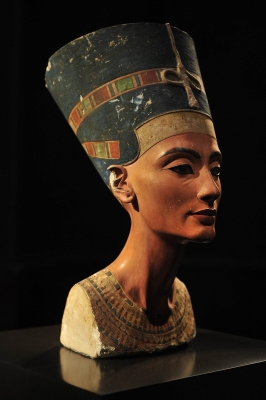
One of the most mysterious and powerful women in ancient Egypt, Nefertiti was queen alongside Pharaoh Akhenaten from 1353 to 1336 B.C. and may have ruled the New Kingdom outright after her husband’s death. Her reign was a time of tremendous cultural upheaval, as Akhenaten reoriented Egypt’s religious and political structure around the worship of the sun god Aten. Nefertiti is best known for her painted sandstone bust, which was rediscovered in 1913 and became a global icon of feminine beauty and power.
Nefertiti may have been the daughter of Ay, a top adviser who would go on to become pharaoh after King Tut’s death in 1323 B.C. On the walls of tombs and temples built during Akhenaten’s reign Nefertiti is depicted alongside her husband with a frequency seen for no other Egyptian queen. In many cases she is shown in positions of power and authority—leading worship of Aten, driving a chariot or smiting an enemy.
After Nefertiti had given birth to six daughters, her husband began taking other wives, including his own sister, with whom he fathered the future King Tut (Tutankhamen). Nefertiti’s third daughter Ankhesenpaaten would eventually become her half-brother Tutankhamen’s queen.
On December 6, 1913, a team led by German archaeologist Ludwig Borchardt discovered a sculpture buried upside-down in the sandy rubble on the floor of the excavated workshop of the royal sculptor Thutmose in Amarna. The painted figure featured a slender neck, gracefully proportioned face and a curious blue cylindrical headpiece of a style only seen in images of Nefertiti. Borchardt’s team had an agreement to split its artifacts with the Egyptian government, so the bust was shipped as part of Germany’s portion. A single, poor photograph was published in an archaeological journal and the bust was given to the expedition’s funder, Jacques Simon, who displayed it for the next 11 years in his private residence.
In 1922 British Egyptologist Howard Carter discovered King Tut’s tomb. A flurry of international attention followed, and the image of Tut’s solid gold funerary mask was soon a global symbol of beauty, wealth and power.
Picture Credit : Google

